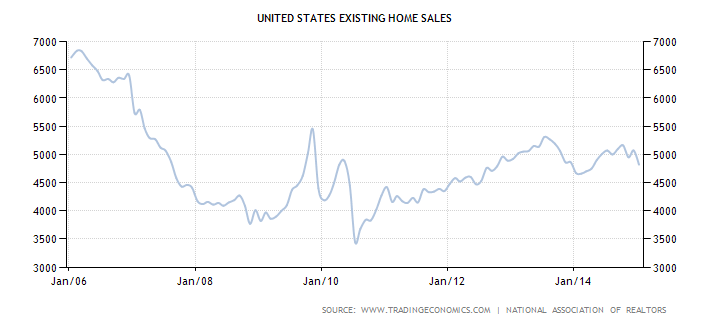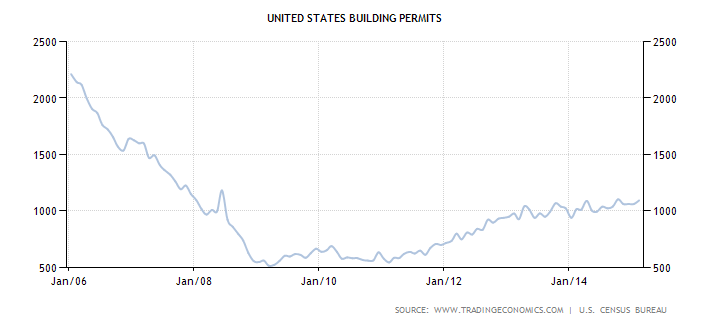This morning, Wall Street digested the latest housing statistics, with February housing starts tumbling 17% from a month prior, while new applications for building permits rose 3%.
Housing Data in Perspective
While there are numerous housing market data points we can look at, I’d like to focus on two key metrics: existing home sales and building permits. These statistics capture two sides of the market – the future construction of new homes as well as the sales of existing homes.
Below is a chart from Trading Economics which shows the number of existing home sales from January, 2006 (pre- housing crash) to January, 2015:

Existing home sales have made some progress in recent years, albeit slowly and not as steadily as many had hoped. Applications for building permits have also increased since the housing market bottom, though applications are far from the highs seen throughout 2005 and 2006:

Housing Headwinds
Theoretically, the housing market should be quite active given the current economic environment. Interest rates are still at all time lows, the job market has improved significantly, and inflation continues to stay below the Fed’s target. One of the key reasons why the housing market has not bounced back as quickly is because U.S. regulators have continued to crack down on the lending industry, making it harder for families to obtain mortgages.
These rules and regulations, however, are somewhat of a double-edged sword. The reason they were implemented in the first place was to avoid the horrendous and irresponsible lending standards the housing industry had fallen into during the boom. While it is good that banks have avoided subprime lending, the stricter rules have also made it increasingly difficult for even qualified borrowers to obtain credit.
If you look at statistics about first-time home buyers, the data does not paint a cheery picture. In the National Association of Realtors’ annual survey, the share of first-time buyers fell to its lowest point in nearly three decades (since 1987 to be exact). Lawrence Yun, NAR’s chief economist, captured the most significant problem in the current housing market with this statement:
“Rising rents and repaying student loan debt makes saving for a downpayment more difficult, especially for young adults who’ve experienced limited job prospects and flat wage growth since entering the workforce. Adding more bumps in the road, is that those finally in a position to buy have had to overcome low inventory levels in their price range, competition from investors, tight credit conditions and high mortgage insurance premiums.”
An Uncertain Outlook
Lawrence Yun also mentioned how the stronger labor market should eventually translate to higher wages, especially for the generation X first-time home buyers pool. This segment of the population is crucial for the housing market, since historically these individuals should already be buying (or at least close to buying) their first homes.
What is somewhat worrisome, however, is that the Fed is at least considering raising interest rates this year, which would make mortgages more expensive. If wages and economic conditions do not coincide with a rise in rates, the housing market could be in for some significant additional headwinds.
Be sure to follow us on Twitter @Dividenddotcom.





